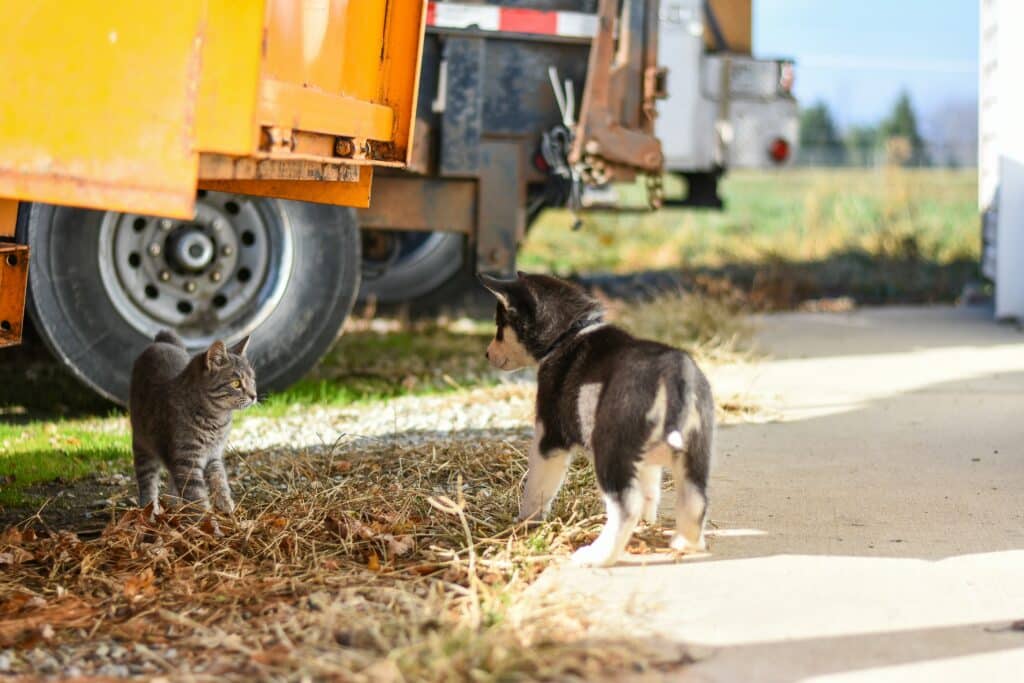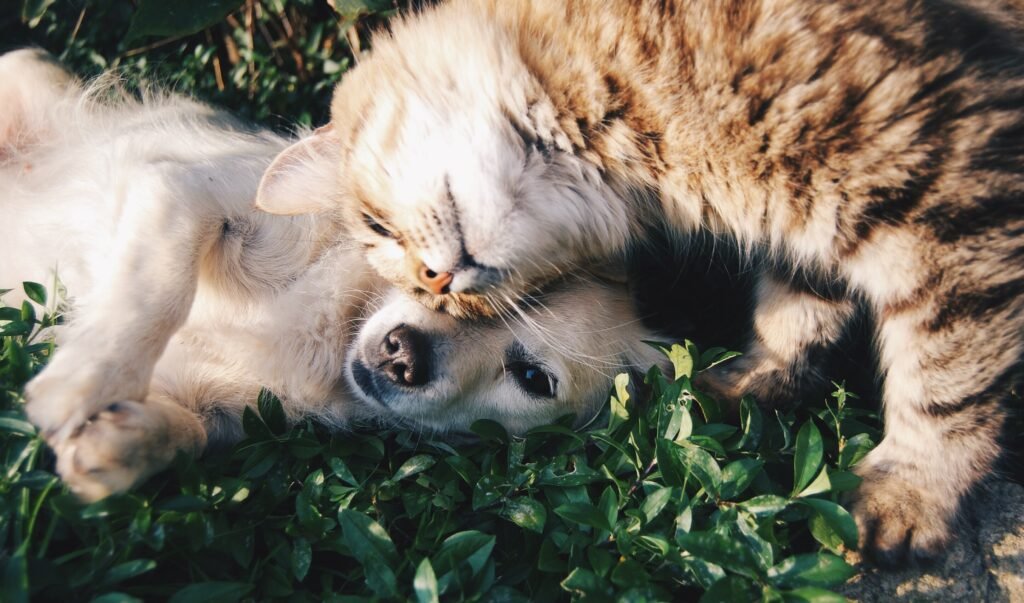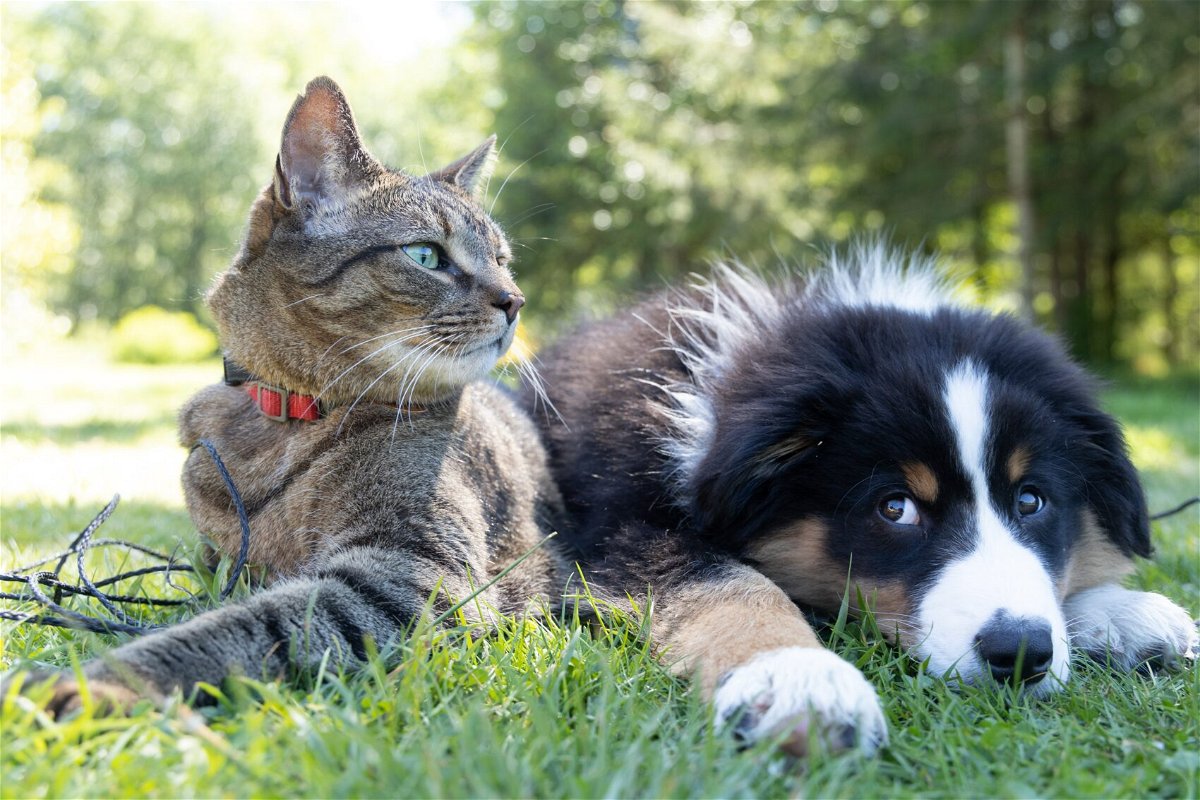We're an affiliate
We hope you love the products we recommend! Just so you know, we may collect a share of sales or other compensation from the links on this page at no additional cost to you. Thank you if you use our links, we really appreciate it!
Adopting a new cat can be challenging for your resident dog. After all, dogs are protective animals and tend to have a natural instinct to guard their space against outsiders.
This means that having another animal enter the home could lead to some initial feeling of distrust or even fear on the part of your dog.
Fortunately, learning how to introduce a cat to a dog is easy with patience and preparation.

It’s important to take things slowly at first and make sure both animals feel comfortable and secure with each other before taking things further.
However, with the right technique, you can ease the transition between the two pets in no time!
The introduction process should never be rushed. Take your time and make sure to follow the simple steps.
3 Things to Do Before Bringing a New Cat to Your Dog
1. At the adoption center
Right from the animal shelter, you should proceed to your vet and get the cat examined. They should be tested for all common cat health problems to rule out any underlying condition.
Based on the records from the adoption center, your vet will advise you on the cat’s vaccination shots and schedule. Make sure to fully vaccinate your cat before proceeding to your home.
If they are found to suffer any condition, the vet will prescribe immediate treatment.
2. Prepare your house to host a cat
Letting your pets share accessories at this point is not a good idea. This is the best time to start sourcing the best products for your cat.
You may be required to swap the accessories later in the introduction process, but let the dog and cat have their own items.
Look for the best cat foods, cat feeders, litter boxes, cat beds, water fountains, interactive cat toys, and any other essential items they may need.
3. Get a separate room for your cat
Cats are territorial and you need to assure them that they will have their space in your home. Prepare a small enclosed room that will host your cat during this introduction process.
The room should be well-ventilated, with enough lighting, and have a locking door.
Place all the essential cat accessories in this room in readiness to host your cat. Get liquid catnip and spray it on your cat’s new accessories. This is a simple way to welcome the cat to their new home.
How To Introduce a New Cat to Your Dog in 7 Steps
Once you have this process down, you will find that it is much easier to introduce a cat to a dog than you initially thought.
Dogs are naturally curious, active pets, so they will most likely be interested in the new feline addition to the family.
Cats are territorial and they will be less likely to be interested in a curious dog. So, you will have to be patient when introducing your pets to one another.
You can introduce your cat to most dogs but there are specific dog breeds that do well with cats. These dogs are known to have a calm demeanor hence they can easily make friends with felines.

During the process, you must remain very observant. If you notice any signs of hostility, then you should retract the process for a moment and let them cool down.
These steps are not very difficult, but you must follow them carefully.
1. Arriving at home
When arriving home with your new cat, you need to ensure that they do not meet the dog immediately.
You can use a dog crate to restrict your canine friend during this brief period. Take your cat to their new room and allow them to rest.
2. Let the new cat rest
Give your cat two or more days to settle in their room before introducing them to your dog. Your cat’s room should contain all the things needed to keep them comfortable.
Provide your cat with enough supply of food and water. Have an automatic cat litter box and a comfy bed to keep them comfortable in their new room.
Don’t forget to clean the room regularly to maintain hygiene. You can use a pet odor eliminator to remove all messy stains and for better results.
3. Swap scents
Right before their first meeting, you need to switch your pets’ scent. By doing this, you are letting them know that they have a nearby housemate.
You can start doing this by stroking your cat with a clean cloth and letting your resident dog smell the cloth.
Do the same with the dog and leave the piece of cloth in your cat’s room. Allow your cat to sniff and poke around the cloth slowly when alone in the room. You can then proceed to switch the bedding for both pets.
When introducing a new scent, it is normal for your pets to show some reluctance. You will need to repeatedly expose them to the smell before they become comfortable.
If you notice that either of the pets is resisting the scents for too long, then you might want to repeat this step until you see an improvement.
4. Switch the pets’ rooms
Once your cat has identified the scent of the resident dog, it is now time to let them move freely within the house.
Get a tall cat tree for your new feline to expand their territory. This is a more comfortable place to rest, scratch, and hide.
You can also put your resident dog in your cat’s room during this time. The dog will get accustomed to the cat’s scent when they stay in that room for a while.
Your cat may hide under the couch, tables, or behind the curtain for the first time when you release them to the entire house. This is perfectly normal because of the changes in the environment.
You may notice your new cat rubbing themselves against the wall and furniture in the house, leaving a scent trail behind. Cats do this to mark their territory. This will inform your dog of the presence of a new cat within the house.
You can repeat this process for some time until you notice your cat is comfortable walking around the house freely.
5. Let them greet each other
For this stage, you will need another family member to help you in introducing the pets. Put your dog on a leash and guide them to the living room. Command your dog to ‘sit down and stay’ on the carpet or couch.
Let one of your family members bring the new cat into the living room and release them on a couch (preferably opposite your dog).
The cat should not be physically restrained. Give them the freedom to move freely within the house. The other person should then give some treats to the cat.
All this while, you should be carefully observing how your dog looks at the new family pet. If they have a relaxed body with floppy ears, then they are comfortable with the cat.
A more curious dog would want to know who the new member of the house is. Alert ears and sharp eyes will indicate that they are attentive and carefully observing the cat.
You can create at least two of these short visits to let your pets know each other. This also helps your dog to see that the new cat is embraced by the whole family.
6. The long-awaited first meeting
Make sure that both the dog and cat are comfortable with each other’s presence before you let them meet at close sight. You risk scaring the cat away if you rush things and this can make the process much harder.
This meeting should preferably take place when both pets have had their meals. Have your dog on a slack leash when taking them to meet the cat. This will give you control of the situation in case things get tough.

Guide your cat to sniff and investigate their new housemate. Be on the lookout for any warning signs that both pets may show.
It is normal for cats to show a sad face during this first meeting. Make sure to guide your dog not to reiterate the same feeling to your cat.
During this first meeting, the cat might be scared and run into hiding. This is normal and it occurs especially if the dog is large and scary.
7. Reward your dog for staying calm
You should reward your dog if they stay calm around the newcomer. Start training your dog not to chase the cat or be rough with them. It is very easy for a dog to injure a cat when chasing them.
In case the dog becomes hostile, do not punish them especially when the cat is around. You can simply retract the process and allow them to cool down.
Punishing the dog in the presence of the newcomer will make them associate the punishment with the cat. This will make the upset pup avoid the feline in subsequent meetings.
If you have a resident cat, read our guide on how to introduce cats to each other.
How To Introduce a Scared Cat To A Dog
Special care should be taken when dealing with a frightened cat. You need to focus more on the scent-swapping step when following the above process.
Before the first face-to-face meeting with the pets, you can have them look at each other on the opposite sides of a transparent door first. You may also restrict your pets using a dog gate and then let them sniff and investigate each other from both sides.
This will allow them to get familiar with each other while assuring the fearful cat of their safety. You can repeat this process until your new feline seems comfortable meeting the resident dog face to face.
How To Introduce a Kitten to A Dog
Introducing kittens to dogs can be a challenging task, but it shouldn’t stress you. Should I get a kitten for my dog? Yes, it is in fact better. A young cat is open to forming new friendships with all pets in the house as they grow.
In addition to the above process, you can introduce your kitten to a dog with these slight modifications.
- First, you need to wait until the kitten is at least 6 months old (but preferably 8 months or older) before introducing them.
- Make sure that the dog is well-socialized with other dogs and cats, as well as strangers, before introducing them.
- Bringing your kitten from their room should be done slowly over several days or weeks. It’s too much pressure if you’re bringing in a kitten who hasn’t spent any time around other pets.
- Ensure that your kitten has a place where they can hide if they feel threatened. Their hiding place should not be accessible to your dog who should be on a leash throughout this process.
- You should carefully observe your kitten’s body language for any signs of tension or nervousness. Don’t worry if your kitten is nervous. You should stop the process and take them to their room to calm down. You can spray the room with a natural cat pheromone diffuser to help them to calm down.
- You can then gradually make the supervised visits longer and reward both pets when being calm during the process.

Despite the calmness of a dog toward young kitties, there are some dangers of bringing a kitten into a home with a dog; some of which include:
- The kitten will always feel vulnerable.
- They may become seriously injured in case of a scuffle.
- Kittens may fail to show warning signs when in danger.
- They may fail to eat when in too much pressure.
After introducing your new kitten to the dog, make sure to give them plenty of time to play and get to know each other.
Make sure they have time alone as well; if you walk out the door, don’t always take the cat/dog with you.
Allow the two of them to become acquainted without outside interference. The introduction period will vary for every situation, but if all goes well, your new cat and dog can be best friends!
What To Do If the Cat Gets Aggressive
When your cat gets aggressive, you should back off the process for a while and let the pets retreat to their rooms.
An aggressive cat may easily scratch your dog and this might lead to serious injuries and make the introduction process more difficult.
Once a dog is scratched by a cat, it will be hard to re-introduce the cat as a friendly housemate. Never allow aggressive behavior to reach that level.

You need to take control of this situation before the resident dog gets annoyed and becomes violent too.
Dogs are larger and can be stronger than cats. Their aggression might turn out to be very untidy with possible injuries.
We have an article that explains in detail how to deal with an aggressive cat.
6 Warning Signs When Introducing Cats to Dogs
It’s important to watch for signs that the pets may be afraid, nervous, or stressed. These can cause them to react aggressively or even fight.
If you notice any of these signs in your cat and dog, then it’s best to take them away from each other before trying again.
1. Cat’s flattened ears
Pushed back ears are a sign that the new cat is feeling threatened. This shows that they are feeling uncomfortable in the presence of the resident dog.
2. The cat may growl or hiss
The new cat might growl and hiss to show his dissatisfaction, fear, and anger in the presence of the dog. They may also produce these sounds when they notice an uncomfortable move by the dog that threatens them.
3. The cat may stop eating and drinking
The new cat may feel compromised to the extent that they don’t want to eat and drink. This is a sign that your cat is not happy and they feel like their new territory has been encroached on.
In severe cases, the cat might not be willing to come from their room. They will be comfortable hiding and staying away from the dog by all means.
4. The dog remains stiff
Your resident dog might remain overly focused on your new cat. They may fix their eyes on the cat and their room. This is a sign that your dog feels intruded on and is curious to find out who the stranger is.
5. The dog may bark
Dogs always bark when they want to scare someone or in quest of the owner’s attention. The resident dog might bark off at the new cat to scare them away.
6. Fighting
We recommend that you always introduce your pets while closely monitoring them. But in case the worse happens, you can know that pets have not embraced each other when they fight.
The good bit is that this fight is usually characterized by a loud hissing sound from the cat and continuous growling from the dog. This makes it easier to know when things are worse.

Fighting can be dangerous and you should never let the anger escalate to this point. If it has happened, you need to swiftly come through and separate your pets from the scuffle. Take them to their respective rooms and allow them some time to calm down.
We have a comprehensive guide that outlines what you can do to stop dog aggression towards cats. The process is simple and effective in corrective aggressive behavior in dogs.
How Long Does It Take for A Cat to Get Used to A Dog
All dogs and cats are different. There is no standard time when you should expect dogs to embrace cats as their housemates.
Some only require a few weeks to embrace each other while others go upwards of months before they get acquainted.
On average, you can expect your pets to get along between two weeks and a month if they are not overly curious and territorial.
With proper introduction, even the worst dog breeds for cats can get along with feline housemates. Just be patience with them and make sure to always supervise the introduction process.
When To Call for Help
If you notice that your new cat and resident dog cannot simply stay in the same house no matter what then you need to seek professional help.
Please be patient before you take this decision. You could consult an animal behaviorist who will advise and work on your pets’ behavior to see what can be done.
5 Signs Your Cat and Dog Are Starting to Get Along
After some time introducing your pets, you may start to notice some signs that they are getting along.
1. They visit each other
Your dog is now waiting for your cat outside their room. This is a sign that they already missed each other and are willing to spend much time together.
2. They play together
This is one of the most obvious signs that your dog and cat are finally embracing each other. They get immersed in their games and truly enjoy sharing their toys.
3. They snuggle and sleep together
When the dog and cat start touching and snuggling each other, it means that they have built their trust and friendship.

This newly found affection will transcend the simple snugs and the pets can now sleep together on one couch or bed.
This shows that they have built a bond and can now sleep together.
4. They have no issues eating together
During meal time, you might notice that your pets can now swap their food and water bowls without resistance.
This is a sign that they are getting along well and can even eat from the same bowl. Make sure to use pet food that can be eaten by both dogs and cats if their feeding area is too close.
You might want to use elevated dog bowls to differentiate between your pets’ food and water items.
5. They want to exercise together
Friendly dogs and cats would often want to go together for their evening walks and runs. You may notice that they do not want to leave each other back at home when you gear up for exercise.
Dogs may run faster than cats, but when they are best friends, they maintain a close pace.
Dogs and cats can take part in the same exercises but you should vary the intensity to match their individual needs.
Wait For the Results
The best way to introduce a cat to a dog is to make it gradual and supervised. Be on the lookout for any warning signs during this period and get ready to calm any hostile situation.
When you have successfully done the introduction process, you need to make sure that both pets get along well.
This could take many days, so be patient! It is important to give them some time to get used to one another and figure out each other’s personalities.
Laura is the founder of Furs'n'Paws. She is a also a pet writer and expert with more than 20 years of experience of working with dogs and cats. She developed a very strong love for animals at a young age. Her passion led her to establish a thriving pet sitting and dog walking business in Dubai. As an expert in pet training, behavior, and nutrition, Laura is committed to helping pet owners and pet lovers by offering high-quality information on a wide range of topics.



No responses yet